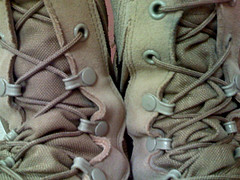Actually it was a day-long Medical Library Association continuing education course called e-Science Bootcamp. The course was developed by the librarians at the Claude Moore Health Sciences Library, University of Virginia and supported by NN/LM-SE/A. (Follow the link to see what all those letters mean!)
It was a full day, with 5 sessions, lunch, and a small group session at the end. I met  many motivated librarians and learned tons about how libraries are trying to help researchers deal with NSF’s Data Management Plan requirements.
many motivated librarians and learned tons about how libraries are trying to help researchers deal with NSF’s Data Management Plan requirements.
In three of the sessions a researcher described their research and the kinds of data they create. Kimberly Kelly works with a lot of images and movies. She also described how many grants she needs to write and how much time that takes. Deborah Lannigan’s lab works with images, movies, and more ‘usual’ chemical and biological data. We were able to tour Dr. Lannigan’s labs; her grad students were very helpful in describing and demonstrating how the data were generated, analyzed, and stored. J. Randall Moorman works with physiological data. He described the work he’s doing with neonatal intensive care units and introduced us to a repository of physiological data, Physionet.
In the other two sessions Andrew Sallans described the creation of the Scientific Data Consulting Group (SciDaC) unit of the University of Virginia Libraries and the services they offer. He and his colleague have created tools to help researchers create the Data Management Plan that NSF now requires in grant submissions. They also conduct ‘data interviews’ with researchers as part of that process. They believe they will need to expand this service as more funding agencies add a data management plan requirement.
So why did I attend? I had three basic reasons:
- To see what other libraries are (or aren’t) doing to help researchers respond to this new NSF requirement.
- To improve my understanding of the NSF requirement since The Sheridan Libraries’ Digital Research and Curation Center is working on the NSF Data Conservancy project. (You can follow them on Facebook, Twitter, and YouTube.)
- I’m really curious!
